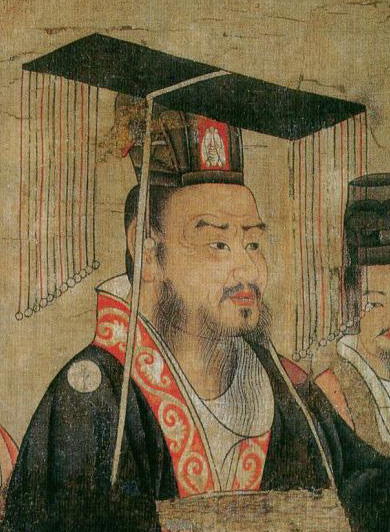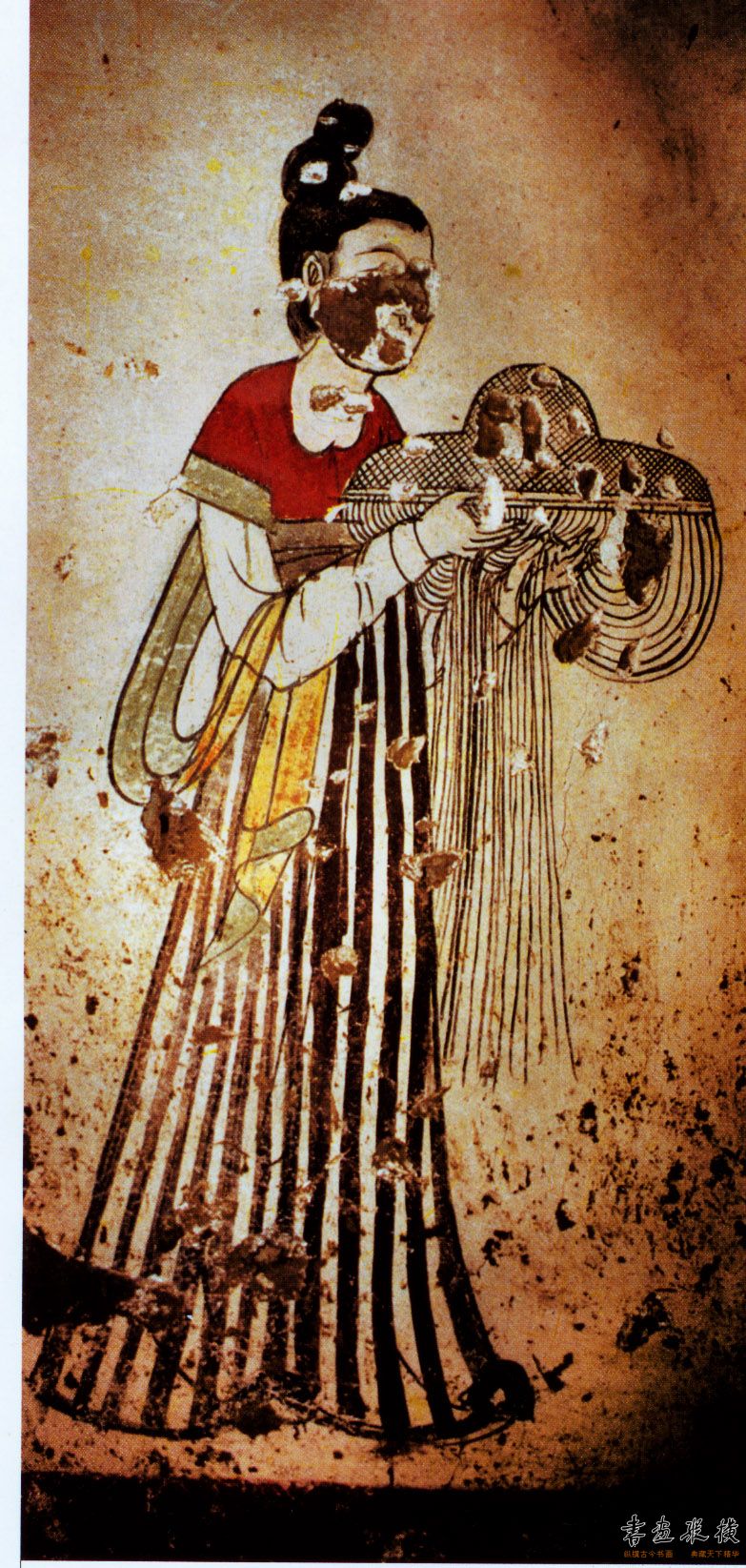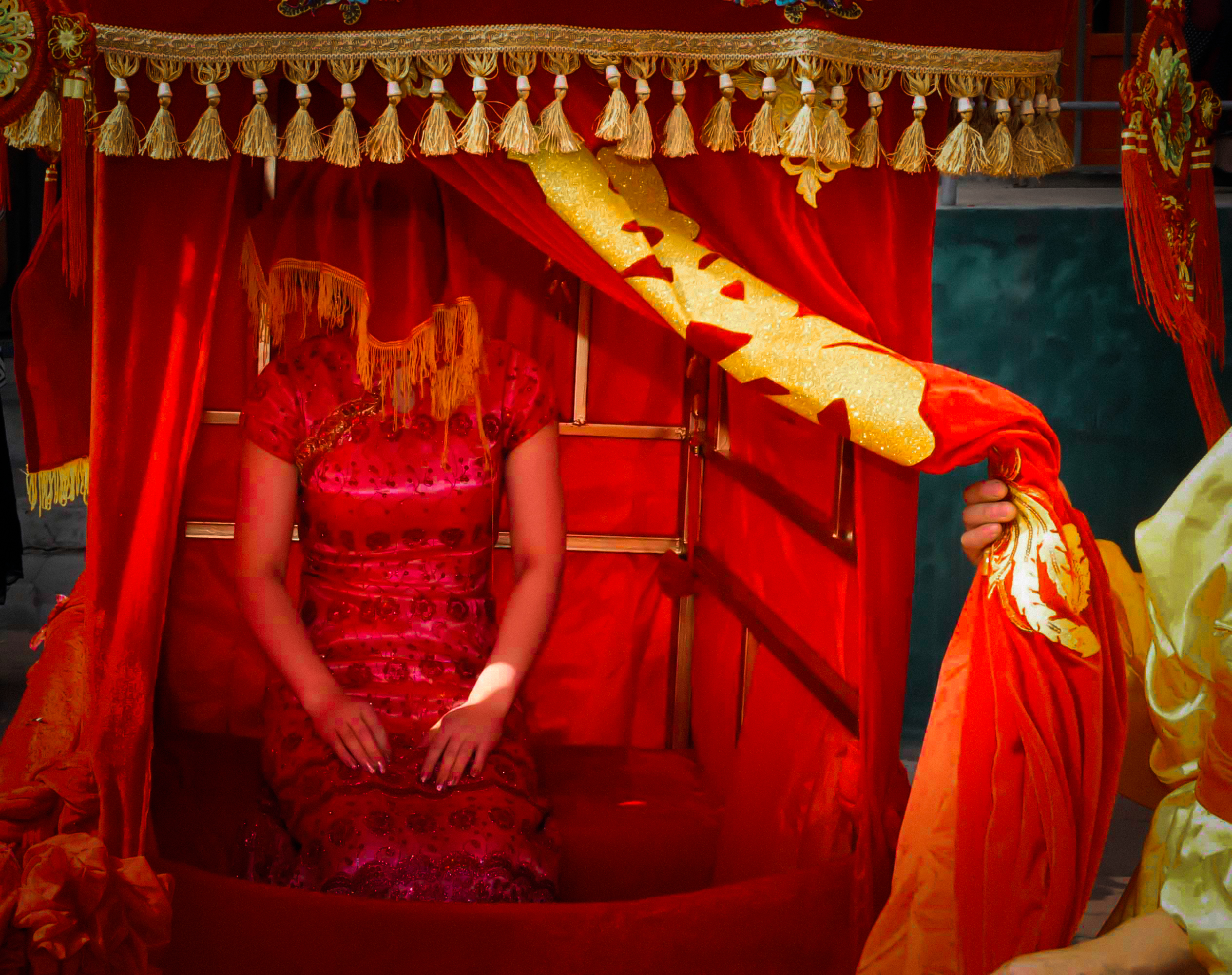|
Honggaitou
A (), also shortened to () and referred to as red veil in English, is a traditional red-coloured bridal veil worn by the Han Chinese brides to cover their faces on their wedding ceremony before their wedding night. The is worn along with a red wedding dress. Veils have been used in China since the Han dynasty. The custom of wearing the for wedding ceremonies can be traced back to the Song dynasty period. The custom of wearing the , along with the traditional red wedding dress, continues to be practiced in modern-day China. However, under the influence of Western culture and globalization, most Chinese brides nowadays wear white wedding dresses and a white veil, an imitation of Western Christian weddings, instead of the red wedding dresses and . Cultural significance and symbolism In Chinese culture, the colour red () symbolizes good luck, happiness, joy, and celebration. The colour white, which is used in Western Christian weddings, symbolizes death in Chinese culture rath ... [...More Info...] [...Related Items...] OR: [Wikipedia] [Google] [Baidu] |
List Of Hanfu Headwear
Chinese headwear have a long history. According to some scholars, China used to be called "the Kingdom of Headwear" by people due to its variety of colourful and artistic style of hair ornament. There were various categories for headwear including (), (), (), (), and (). Chinese people also wore Chinese hairpins. Chinese women, in particular, like to use flowers (either natural or artificial) as hair decorations for centuries; they also wore shubi in their hair and sometimes wore the honggaitou on their weddings. Types of Headwear for males Types of headwear for females See also * Chinese hairpin * Hanfu * Honggaitou * List of Hanfu * Shubi - Chinese comb *Tian-tsui {{Short description, Traditional Chinese feather art Tian-tsui (Chinese traditional: 點翠, Chinese simplified: 点翠, pinyin: diǎncuì, "dotting with kingfishers") is a style of Chinese art featuring kingfisher feathers. For 2,000 years, the C ... References {{Types of Han Chinese clothing ... [...More Info...] [...Related Items...] OR: [Wikipedia] [Google] [Baidu] |
Mili (veil)
Mili () is a type of Chinese veil which originated from Hufu of the Rong and Yi people cultures. In the Sui to early Tang dynasties, the mili was typically to a body-long veil which was used to conceal the body of women; it was a form of burnoose which was burqua-like. The full-body mili then evolved into the weimao by the end of the Sui dynasty. The full-body mili continued to be worn in the Tang dynasty,but started to lose popularity by the middle of the 7th century. It eventually disappeared completely by 705 AD. Some Tang dynasty mili also only covered the women's face and neck areas. Cultural significance Despite its foreign origins rooted in the Rong and Yi cultures, the full-body mili was perceived as an expression of highest propriety in the Central plains. This was also recorded in the New book of Tang, which described the mili as "originating from the barbarians" but was ideal to protect women's modesty as it covered and hid the entire body. History Origins ... [...More Info...] [...Related Items...] OR: [Wikipedia] [Google] [Baidu] |
Traditional Chinese Wedding Ceremony (Honggaitou)
A tradition is a belief or behavior (folk custom) passed down within a group or society with symbolic meaning or special significance with origins in the past. A component of cultural expressions and folklore, common examples include holidays or impractical but socially meaningful clothes (like lawyers' wigs or military officers' spurs), but the idea has also been applied to social norms such as greetings. Traditions can persist and evolve for thousands of years—the word ''tradition'' itself derives from the Latin ''tradere'' literally meaning to transmit, to hand over, to give for safekeeping. While it is commonly assumed that traditions have an ancient history, many traditions have been invented on purpose, whether that be political or cultural, over short periods of time. Various academic disciplines also use the word in a variety of ways. The phrase "according to tradition", or "by tradition", usually means that whatever information follows is known only by oral tradition, ... [...More Info...] [...Related Items...] OR: [Wikipedia] [Google] [Baidu] |
Chinese Culture
Chinese culture () is one of the world's oldest cultures, originating thousands of years ago. The culture prevails across a large geographical region in East Asia and is extremely diverse and varying, with customs and traditions varying greatly between Province (China), provinces, Cities of China, cities, and even towns as well. The terms 'China' and the geographical landmass of 'China' have shifted across the centuries, with the last name being the Qing dynasty, Great Qing before the name 'China' became commonplace in modernity. Chinese civilization is historically considered a dominant culture of East Asia. With China being one of the Cradle of civilization#Ancient China, earliest ancient civilizations, Chinese culture exerts profound influence on the philosophy, virtue, etiquette, and traditions of Asia. Chinese characters, Chinese ceramics, ceramics, Chinese architecture, architecture, Chinese music, music, History of Chinese dance, dance, Chinese literature, literature, ... [...More Info...] [...Related Items...] OR: [Wikipedia] [Google] [Baidu] |
Chinese Headgear
Chinese can refer to: * Something related to China * Chinese people, people of Chinese nationality, citizenship, and/or ethnicity **''Zhonghua minzu'', the supra-ethnic concept of the Chinese nation ** List of ethnic groups in China, people of various ethnicities in contemporary China ** Han Chinese, the largest ethnic group in the world and the majority ethnic group in Mainland China, Hong Kong, Macau, Taiwan, and Singapore ** Ethnic minorities in China, people of non-Han Chinese ethnicities in modern China ** Ethnic groups in Chinese history, people of various ethnicities in historical China ** Nationals of the People's Republic of China ** Nationals of the Republic of China ** Overseas Chinese, Chinese people residing outside the territories of Mainland China, Hong Kong, Macau, and Taiwan * Sinitic languages, the major branch of the Sino-Tibetan language family ** Chinese language, a group of related languages spoken predominantly in China, sharing a written script (Chinese c ... [...More Info...] [...Related Items...] OR: [Wikipedia] [Google] [Baidu] |
Chinese Traditional Clothing
Chinese can refer to: * Something related to China * Chinese people, people of Chinese nationality, citizenship, and/or ethnicity **''Zhonghua minzu'', the supra-ethnic concept of the Chinese nation ** List of ethnic groups in China, people of various ethnicities in contemporary China ** Han Chinese, the largest ethnic group in the world and the majority ethnic group in Mainland China, Hong Kong, Macau, Taiwan, and Singapore ** Ethnic minorities in China, people of non-Han Chinese ethnicities in modern China ** Ethnic groups in Chinese history, people of various ethnicities in historical China ** Nationals of the People's Republic of China ** Nationals of the Republic of China ** Overseas Chinese, Chinese people residing outside the territories of Mainland China, Hong Kong, Macau, and Taiwan * Sinitic languages, the major branch of the Sino-Tibetan language family ** Chinese language, a group of related languages spoken predominantly in China, sharing a written script (Chi ... [...More Info...] [...Related Items...] OR: [Wikipedia] [Google] [Baidu] |
Hanfu
''Hanfu'' () is the traditional styles of clothing worn by the Han Chinese. There are several representative styles of ''hanfu'', such as the (an upper-body garment with a long outer skirt), the (an upper-body garment with a long underskirt), the and the , and the (an upper-body garment with ku trousers). Traditionally, ''hanfu'' consists of a ''paofu'' robe, or a ''ru'' jacket worn as the upper garment with a ''qun'' skirt commonly worn as the lower garment. In addition to clothing, hanfu also includes several forms of accessories, such as headwear, footwear, belts, jewellery, and handheld fans. Nowadays, the hanfu is gaining recognition as the traditional clothing of the Han ethnic group, and has experienced a growing fashion revival among young Han Chinese people in China and in the overseas Chinese diaspora. After the Han dynasty, ''hanfu'' developed into a variety of styles using fabrics that encompassed a number of complex textile production techniques, part ... [...More Info...] [...Related Items...] OR: [Wikipedia] [Google] [Baidu] |
Fengguan
(), also known as phoenix coronet or phoenix hat, is a type of (a type of Chinese traditional headgear) for women in . It was worn mainly by noblewomen for ceremonies or official occasions. It is also traditional headgear for brides and could be worn in set of Traditional Chinese wedding dress attire, such as the '. Terminology ' literally means "phoenix crown" in English language, a name that originates from its adornments: phoenixes made of inlaid kingfisher feathers, as well as gold dragons, beaded pheasants, pearls, and other gemstones. One of the earliest phoenix crowns that has been excavated belonged to Empress Xiao of the Sui dynasty. The type became most popular during the Ming dynasty, with many changes made over time. History ' evolved from ' (), the Chinese hairpin worn by empresses and emperor's concubines. The wearing of ' was issued by Emperor Qin Shihuang (259BC–210BC). It was in Eastern Jin (317–420 AD) that the word ' first came up; however, it was ... [...More Info...] [...Related Items...] OR: [Wikipedia] [Google] [Baidu] |
Cheongsam
''Cheongsam'' (, ), also known as the ''qipao'' () and sometimes referred to as the mandarin gown, is a Chinese dress worn by women which takes inspiration from the , the ethnic clothing of the Manchu people. The cheongsam is most often seen as a longer, figure-fitting, one piece garment with a standing collar, an asymmetric, left-over-right () opening and two side slits, and embellished with Chinese frog fasteners on the lapel and the collar. It was developed in the 1920s and evolved in shapes and design over years. It was popular in China from the Republic of China (1912–1949), 1920s to 1940s, overlapping the Republican era, and was popularized by Chinese socialites and high society (social class), high society women in Shanghai. It was also one of the national dress of the Republic of China (1912–1949), Republic of China in 1929 and is currently the national dress of China, which symbolizes a generic Chinese national identity rather than a specific ethnic and/or ancest ... [...More Info...] [...Related Items...] OR: [Wikipedia] [Google] [Baidu] |
Qungua
(), also known as (), or (), or (), is one type of two-piece ceremonial traditional Chinese wedding set of attire, which is composed of a jacket called () and of a long Chinese skirt called (). The ' is a type of Hanfu worn by Han Chinese brides and originated in the 18th century during the Qing dynasty. It eventually became the traditional wedding attire of Cantonese brides in the Guangdong regions. It is traditionally handmade and is decorated with dragons and phoenixes embroideries. Nowadays, the ' is still popular as a wedding dress in China, including in Hong kong and Macau. Origins and tradition Back in Ming dynasty, the women wedding dress worn by nobles and commoners was known as ' () composed of the ' and '. The wedding dress worn in Ming dynasty continued to influence the wedding dress of the later centuries. What is known as ' only started to be worn in the 18th century during the Qing dynasty. The 'originated in Guangdong when Liang Zhu'','' a Guangdong Qing ... [...More Info...] [...Related Items...] OR: [Wikipedia] [Google] [Baidu] |
Litter (vehicle)
The litter is a class of wheelless vehicles, a type of human-powered transport, for the transport of people. Smaller litters may take the form of open chairs or beds carried by two or more carriers, some being enclosed for protection from the elements. Larger litters, for example those of the Chinese emperors, may resemble small rooms upon a platform borne upon the shoulders of a dozen or more people. To most efficiently carry a litter, porters either place the carrying poles directly upon their shoulders or use a yoke to transfer the load from the carrying poles to the shoulders. Definitions A simple litter consists of a sling attached along its length to poles or stretched inside a frame. The poles or frame are carried by porters in front and behind. Such simple litters are common on battlefields and emergency situations, where terrain prohibits wheeled vehicles from carrying away the dead and wounded. Litters can also be created quickly by the lashing of poles to a chair. ... [...More Info...] [...Related Items...] OR: [Wikipedia] [Google] [Baidu] |
Christians
Christians () are people who follow or adhere to Christianity, a monotheistic Abrahamic religion based on the life and teachings of Jesus Christ. The words ''Christ'' and ''Christian'' derive from the Koine Greek title ''Christós'' (Χριστός), a translation of the Biblical Hebrew term ''mashiach'' (מָשִׁיחַ) (usually rendered as ''messiah'' in English). While there are diverse interpretations of Christianity which sometimes conflict, they are united in believing that Jesus has a unique significance. The term ''Christian'' used as an adjective is descriptive of anything associated with Christianity or Christian churches, or in a proverbial sense "all that is noble, and good, and Christ-like." It does not have a meaning of 'of Christ' or 'related or pertaining to Christ'. According to a 2011 Pew Research Center survey, there were 2.2 billion Christians around the world in 2010, up from about 600 million in 1910. Today, about 37% of all Christians live in the Am ... [...More Info...] [...Related Items...] OR: [Wikipedia] [Google] [Baidu] |
.jpg)




.jpg)



